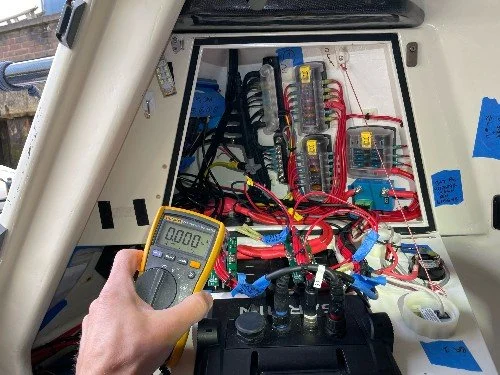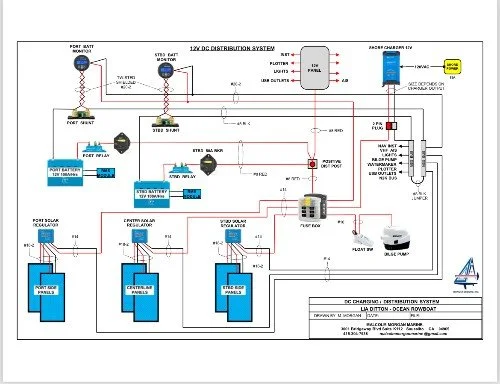One month to go!
In this limited amount of time that I have left before leaving for Gran Canaria in December, my attention has been focussed on tidying up my knowledge and skills which are vital for the success of my project, particularly related to the boat’s electrical set-up. There have been some important changes in my team, which make me a lot more confident about being able to reach our goals. The boat is now out of the water for the final stages of the prep, which will involve an inventory of the equipment and food and trying to fit it into it in a way that is safe and with an easy access to the kit that I might need in an emergency.
My journey is fully planned and the ferry tickets are booked. I am leaving the UK with the boat in tow on December 10th and arriving in Gran Canaria on the 15th with a plan to push off to Barbados before Christmas.
Onwards and upwards!
Less rowing, more learning!
October has not been a good month for rowing practice – strong winds on my days off and calmer weather when I was at work! I have managed to squeeze in a few days of practice and even managed to almost reach the Needles on one of them (I had to turn back when the tide turned).
I have spent a most of my “free” time on “classroom learning”, mainly learning about the boat’s electrical system. Although there is no motor (I am the one!), there is still some important equipment that needs electrical power to make my life easier, most notably my watermaker that produces five litres of water per hour. It is basically a strong hydraulic pump that pushes the sea water through a series of filters. The water is sucked from a compartment in the middle of the boat’s hull which is flooding in through a hole in its bottom currently closed by a plug. I cannot wait to see what happens when I pull that plug out during my practice row to test the watermaker in the coastal waters of Gran Canaria!
The watermaker is the hungriest device on my boat needing about 5 Amp per hour (Ah) of current. Luckily, I will only need to run it for about two hours per day and I really hope that the sun will be out for at least those two hours! I do have a manual watermaker, but it only produces 2 litres of water per hour so I would need to pump it continuously for about 5 hours per day, which in addition to a fairly intense workout takes 5 hours away from rowing the boat.
The electrical watermaker in the forward cabin.
…and my manual one in case it fails!
In addition to the watermaker, I will have other equipment that will need regular charging like VHF radios, satellite phone and messengers, internet terminal, phone and tablet, as well as a chartplotter. So, knowing your electricity and how to trouble shoot and sort out common problems is essential for the success of my mission. That is why I have taken an online marine electrical course as well as attended an in-person one on 12-V Marine Electrical systems at Chieftain Training Centre. Two days of playing with wires and finding faults in various common boat circuits have been intense and quite useful, particularly because the course instructor Carl Bryan-Brown offered to come and help me with some hands-on tuition on my boat. This turned into two full-on days of not only practical teaching on the boat’s electrical system but also taking some afternoon sights with sextants on a nearby beach! I cannot be more grateful to Carl particularly because he has done it completely free of charge because of my Ukraine medical charity and his personal connections to Ukraine.
Carl spent two days on my boat doing own-boat tuition training free-of-charge!
Measuring current consumption of every piece of kit onboard and meticulously labelling and testing all the cables will help me diagnose and sort out problems while at sea
…and this is how the schematics look like!
Shooting the Sun with sextants at midday - now I understand why pirates had eye patches!
It goes without saying that I have continued with my physical training. Basically, I lift weights 3-4 times per week and do cardio, which is rowing either on the Concept2, or on the water. It is boring to write about it. It is boring to do it too, but as with anything else – one has to have a purpose. I do have one in the form my rowing project; I had one before that, which was to be the oldest person in the gym, rather than the youngest in the nursing home! What is probably worth mentioning is the fact that I have done CPET (cardio-pulmonary exercise testing), which we use on our patients to determine their level of fitness before their surgeries. It is also widely used in sports medicine for obvious reasons.
Basically, you jump on an exercise bike with monitoring leads attached to your body and a tight-fitting mask attached to your face and start pedalling with increased levels of resistance. It is easy to start with, but at some point you body starts “failing” – that is the point when your muscles switch to so-called “anaerobic metabolism”, the one that does not require oxygen and produces energy faster, but is much less efficient than the one that does. Plus, you get muscle pains as a result of rising levels of lactate, which is a byproduct of the anaerobic metabolic pathway. You can feel when that happens and you can measure some important parameters when it does, notably VO2max (maximum oxygen demand before the body switches to the anaerobic pathway) and AT (anaerobic threshold, the point when the aerobic metabolism seizes). VO2max is a very important parameter of an overall fitness and could be increased by specific training. I am pleased to report that my VO2max was 120% my age upper limit of the norm. Most importantly, my peak looked more like a plateau on the graph, which means that I kept going for some time after my body “failed”, which is very encouraging to me as it might be useful during my transatlantic crossing.
In the video below, you could see the last minute (out of ten) of my test as my body was giving up. I can actually recall the moment when it felt like it gave up completely, but I still kept going for another 30 seconds, or so.
There have been some significant changes in my team. Dave “Dinger” Bell has taken over the role of my coach and mentor. Dave’s expertise will be instrumental during these last couple of months as I am getting ready to depart to Gran Canaria in December. He is also going to join me there for the pre-departure checks and will take my car and trailer back to the UK. I have truly been blessed with the people that have been a part of this roller-coaster ride and I am particularly grateful to those who do it because they feel passionate about ocean rowing, and/or want to help my cause.
Dave on “Happy Socks”
Martin Cohen, who is a certified nutritionist, has been instrumental in optimising my gut health, which has been an issue that I have learned to live with. For years, I have been suffering from indigestion which could not be properly diagnosed or treated by hospital doctors. I have tried a few exclusion diets and convinced myself that it was probably gluten, as bread and pasta-free diet kind of improved things for me to be able to get on with life. As the date of my departure was approaching, I was getting more concerned about my ability to live on dehydrated meals and snacks for 60+ days and decided to try the Gut Health Clinic following a recommendation from another ocean rower. Under Martin’s supervision I have had a few tests which confirmed a few food allergies and most importantly a dysbiosis, an imbalance of the gut microbiome which has now been treated successfully with pro- and prebiotics. I am now more confident in my ability to digest my 5-6000 calories per day in the form of dehydrated meals and mostly fat-based snacks (personally, I do not like gorging on carbs during an endurance training due to peaks and troughs in energy levels that are associated with their consumption). I highly recommend investing into gut health if you suffer from any symptoms, whether you prepare to row across the Atlantic, or not!
The boat has been taken out of the water for the final stages of the preparation for my departure in December. I feel I have managed to do some decent number of hours rowing in the Solent and it has been incredibly useful, and an essential part of the training. However, rowing in the relatively sheltered coastal waters is not the same as crossing the Atlantic – the experience has been great for “learning the ropes” (literally!), getting used to the boat and life onboard, but not so much for learning to ride big waves and avoiding being pinned down between them. Well, I will have plenty of time to learn those skills “on the job”.
“Happy Socks” is being lifted out of the water at the Berthon Marina. It is time to go home!
For now, the boat will be parked in front of my house so I could practice loading it up with all the kit that litters my home. It all needs to be packed in a way that would allow me to find things easily and tied down so it does not fly around the cabins, especially the aft one where I will be sleeping when the boat will be rocking on big waves and sometimes capsizing.
All the ferries are booked, and the itinerary is planned – I am leaving the UK on December 10th with a plan to arrive in Gran Canaria on the 15th. I will need a week to get the final checks done and a couple of practice rows which will include testing my watermaker. Then, it is waiting for my weather router Simon Rowell to tell me when to go, but I expect to push off before Christmas.
Lastly, please read my article called “Rowing for Ukrainian medics” recently published at a medical journal, which summarises our project quite well.
Follow me and be part of the journey as I prepare to row the Atlantic 2025
Leo Krivskiy 💙💛












